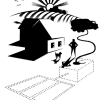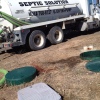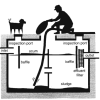A properly designed septic system will have a septic tank with sufficient volume to accumulate solids for several years. As the level of solids rises in the tank, the wastewater has less time to settle properly, and suspended solid particles
flow into the absorption field. If the tank is
not periodically pumped out, these solids will eventually clog the absorption field to the point where a new field will be needed.
When the tank is pumped, the contractor should pump the contents through the manhole, which
is usually located in the center of the tank, rather than through the inspection ports. Pumping through one of the inspection ports could damage the baffles inside the tank (see Figure 1). Damage to the baffles could result in the wastewater flowing directly into the absorption field without the opportunity for the solids to settle.
Remember, commercial septic tank additives do not eliminate the need for periodic pumping and may be harmful to the absorption field. You should check your local health department regulations before using additives. Be sure when the septic tank is pumped that it is completely emptied. It is not necessary to retain any of the solids to restart the digestive process. You do not need biological or chemical additives for successful restart or continuous operation of your septic system, nor should you wash or disinfect the tank after having it pumped.
When to Have Your Septic Tank Pumped
A specific determination of when it’s time to pump out the solids can be made by having the depth of solids and level of scum buildup on
top of the wastewater in the septic tank checked periodically. Two factors affect how often you should have your septic tank pumped. Whether you need to have your tank pumped every year, once every five years, or some other time interval is affected by these factors. The first factor is the size or capacity of the tank itself. If more people are living in the home than when the system was installed, or if new high water use appliances or technologies such as a hot tub or whirlpool bath are now in use, then the capacity may be too small. The more people using a system, the faster the solids will accumulate in the tank, and the more frequently the tank will need to be pumped. Also, the additional surge of water from hot tubs and whirlpool baths may wash solids out of the tank and into the absorption field. An inspection can determine whether the system is of adequate capacity to handle the volume of solids and flow from the number of people in the household
and types of appliances used. A larger capacity system provides better treatment and requires less pumping.
The second factor is the volume of solids in the wastewater. If you have a garbage disposal, for example, you will have to pump out your system more frequently than persons disposing of their food wastes through other means. The use of a garbage disposal may increase the amount of solids in the septic tank by as much as 50 percent. Excessively soiled clothes may add solids to your septic tank. Sometimes, geographical location may also contribute to extra solids ending up in the septic tank. For example, systems in coastal areas may have an accumulation of sand in the septic tank from washing beach clothes.
Reducing the Flow of Wastewater
Generally, the more people, the more water will flow through the system. However, the use of water Cross-section of a two-compartment
conservation device such as a low-flow toilet or septic tank being pumpedshower fixtures greatly reduces the amount of wastewater thus prolonging the life of your septic system. For example, up
to 53 gallons of water are discharged into your system with each load of laundry. If several loads are done in one day, it can put considerable stress on your system. A better practice would be to space your laundry washing throughout the week.
The new ultra low-flush toilets use between 1 and 1.6 gallons of water per flush and will provide as much as a 30 percent water savings. Low-flow faucet aerators on sink faucets, and low-flow showerheads will save additional water. There are also low-flow washing machines which use much less water than standard washing machines.
ABSORPTION FIELD
An absorption field generally does not require any maintenance. However, to protect and prolong the life of the absorption field, follow these simple rules:
• Plant only grass over and near your septic system. Roots from nearby trees or shrubs may clog and damage the absorption field.
• Do not drive or park over any part of your septic system. This can compact the soil and crush your system.
• Direct all wastewater from your home into
the septic tank. This includes all sink, bath, shower, toilet, washing machine and dishwasher wastewaters. Any of these wastewaters can contain disease-causing microorganisms or environmental pollutants.
• Keep roof drains, basement sump pump drains, and other rainwater or surface water drainage systems away from the absorption field. Flooding of the absorption field with excessive water will keep the soil from naturally cleansing the wastewater, which can lead to groundwater and/or nearby surface water pollution.
This article comes from the National Small Flows Clearinghouse. For more information about this or other NSFC products, please contact: National Small Flows Clearinghouse West Virginia University P.O. Box 6064 Morgantown, WV 26506-6064 or phone:
(800) 624-8301, (304) 293-419 www.nsfc.wvu.edu





